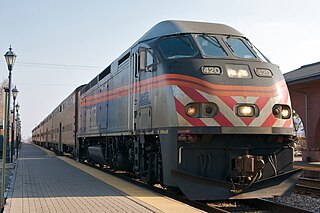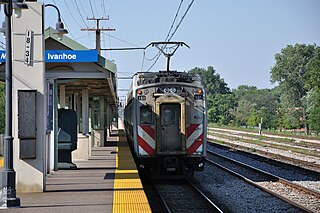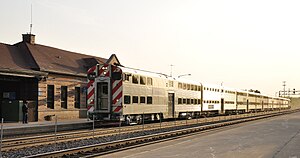
The Empire Builder is an Amtrak long-distance passenger train that operates daily between Chicago and either Seattle or Portland via two sections west of Spokane. Introduced in 1929, it was the flagship passenger train of the Great Northern Railway and its successor, the Burlington Northern Railroad, and was retained by Amtrak when it took over intercity rail service in 1971.

Metra is a commuter rail system in the Chicago metropolitan area serving the city of Chicago and its surrounding suburbs via the Union Pacific, BNSF, and other railroads. The system operates 242 stations on 11 rail lines. It is the fourth busiest commuter rail system in the United States by ridership and the largest and busiest commuter rail system outside the New York City metropolitan area. There were 83.4 million passenger rides in 2014, up 1.3% from the previous year. The estimated busiest day for Metra ridership occurred on November 4, 2016—the day of the Chicago Cubs 2016 World Series victory rally.

The Illinois Zephyr and Carl Sandburg are a pair of passenger trains operated by Amtrak operating along a 258-mile (415 km) route between Chicago and Quincy, Illinois. The trains are a part of the Illinois Service rail network and are partially funded by the Illinois Department of Transportation. Between Chicago and Galesburg, Illinois, the services share the BNSF, with the California Zephyr and Southwest Chief. The Galesburg to Quincy section is only served by the Illinois Zephyr and the Carl Sandburg. Started in November 1971, the Illinois Zephyr is the "longest continuously operated state-sponsored train." The Carl Sandburg was added as a second daily round trip in 2006.

The Union Pacific / North Line (UP-N) is a Metra line in the Chicago metropolitan area. It runs between Ogilvie Transportation Center and Kenosha, Wisconsin; however, most trains terminate in Waukegan, Illinois. Although Metra owns the rolling stock, the trains are operated and dispatched by the Union Pacific Railroad. This line was previously operated by the Chicago & North Western Railway before its merger with Union Pacific, and was called the Chicago and North Western Milwaukee Division and then the Chicago & North Western/North Line before the C&NW was absorbed by Union Pacific in April 1995. It is the only Metra line that travels outside Illinois.

The Union Pacific West Line (UP-W) is a Metra commuter rail line operated by Union Pacific Railroad in Chicago, Illinois and its western suburbs. Metra does not refer to its lines by particular colors, but the timetable accents for the Union Pacific/West line are "Kate Shelley Rose" pink, honoring an Iowa woman who saved a Chicago & North Western Railway train from disaster in 1881. Yellow and green were already selected for the Union Pacific North and Northwest lines respectively, so pink was chosen for this line. Therefore, the UP-W is the only Metra line that uses a color to honor a person instead of a fallen flag railroad. Until 2006, all Metra trains on this line terminated at Geneva. The line runs as part of the Union Pacific Railroad's Geneva Subdivision The line was once known as the Chicago & Northwestern/West Line until UP took over the C&NW in 1995.

The Union Pacific / Northwest Line (UP-NW) is a commuter rail line provided by Metra and operated by the Union Pacific Railroad in Chicago, Illinois and its surrounding suburbs. While Metra does not refer to any of its lines by colors, the timetable accents for the Union Pacific/Northwest line are bright "Viking Yellow," honoring the Chicago & North Western Railway's Viking passenger train.

The North Central Service (NCS) is a Metra commuter rail line running from Union Station in downtown Chicago through northwestern and far northern suburbs to Antioch, Illinois. In June 2018, the public timetable shows 10 weekday departures from Chicago. This line does not run at all on weekends or holidays. While Metra does not explicitly refer to any of its eleven routes by colors, the NCS' timetable accents are lavender, a shade of purple. It is the only Metra line that does not have a specific color for a fallen flag railroad that used to operate on the route.

The Milwaukee District / North Line (MD-N) is a Metra commuter rail line in Chicago, Illinois, and its northern suburbs. Although Metra does not refer to any of its lines by color, the timetable accents for the Milwaukee District / North line are pale "Hiawatha Orange" in honor of the Milwaukee Road's Hiawatha passenger trains.

The Milwaukee District / West Line (MD-W) is a Metra commuter rail line in Chicago, Illinois, and the western suburbs. Metra does not refer to any of its lines by a particular color, but the timetable accents for the Milwaukee District/West line are dark "Arrow Yellow," honoring the Milwaukee Road's Arrow passenger train. Trains are dispatched from CP Rail's American headquarters in Minneapolis.
The Heritage Corridor (HC) is a Metra commuter rail line in Chicago, Illinois, and its southwestern suburbs, terminating in Joliet. While Metra does not refer to its lines by colors, the Heritage Corridor appears on Metra timetables as "Alton Maroon," after the Alton Railroad, which ran trains on this route. The name Heritage Corridor refers to the Illinois and Michigan Canal Heritage Corridor. Established in 1984, it runs parallel to the line.

The Southwest Service (SWS) is a Metra commuter rail line, running southwest from Union Station in downtown Chicago, Illinois, to Manhattan, Illinois. Metra does not refer to its lines by color, but the timetable accents for the SouthWest Service line are "Banner Blue," for the Wabash Railroad's Banner Blue passenger train. The trackage is owned by Metra north of a junction with the Belt Railway of Chicago at Loomis Boulevard, and is leased from Norfolk Southern Railway south of the junction.

The Rock Island District (RI) is a Metra commuter rail line from Chicago, Illinois, southwest to Joliet. Metra does not refer to its lines by color, but the timetable accents for the Rock Island District line are "Rocket Red". This refers to the Chicago, Rock Island and Pacific Railroad's Rocket passenger trains.

The Metra Electric District is an electrified commuter rail line owned and operated by Metra which connects Millennium Station, in downtown Chicago, with the city's southern suburbs. As of 2018, it is the fifth busiest of Metra's 11 lines, after the BNSF, UP-NW, UP-N, and UP-W with nearly 7.7 million annual riders. While Metra does not explicitly refer to any of its lines by color, the timetable accents for the Metra Electric District are printed in bright "Panama orange" to reflect the line's origins with the Illinois Central Railroad (IC) and its Panama Limited passenger train. Apart from the spots where its tracks run parallel to other main lines, it is the only Metra line running entirely on dedicated passenger tracks, with no freight trains operating anywhere on the actual route itself. The line is the only one in the Metra system with more than one station in Downtown Chicago, and also has the highest number of stations (49) of any Metra line.

The Music City Star, also known as the WeGo Star, is a commuter rail service running between Nashville and Lebanon, Tennessee. The service uses the existing track of the Nashville and Eastern Railroad. The line stops at seven stations: Riverfront, Donelson, Hermitage, Mt. Juliet, Martha, Hamilton Springs and Lebanon. The operation covers 32 miles (51 km) of rail line. Service began on September 18, 2006.

The Northern Transcon, a route operated by the BNSF Railway, traverses the most northerly route of any railroad in the western United States. This route was originally part of the Chicago, Burlington and Quincy Railroad, Northern Pacific Railway, Great Northern Railway and Spokane, Portland and Seattle Railway systems, merged into the Burlington Northern Railroad system in 1970.

Naperville is a train station in Naperville, Illinois, United States served by Amtrak, the national railroad passenger system. Amtrak trains stopping at the Naperville station include the California Zephyr, Illinois Zephyr, Carl Sandburg and Southwest Chief. It is also one of two stations in Naperville that serves Metra's BNSF Railway commuter line, and an abundance of Pace bus routes. Naperville station was originally built in 1910 by the Chicago, Burlington and Quincy Railroad. On April 26, 1946, the station was the site of a collision between the CB&Q's Exposition Flyer and Advance Flyer.

The Aurora Transportation Center is a station on Metra's BNSF Railway Line in Aurora, Illinois. The station is 37.1 miles (59.7 km) from Union Station, the east end of the line. In Metra's zone-based fare system, Aurora is in zone H. As of 2018, Aurora is the 13th busiest of Metra's 236 non-downtown stations, with an average of 1,856 weekday boardings. There is a staffed station building. Just north of the station is the Hill Yard, a large coach yard used to store the Metra trains on the BNSF Line. Aurora is a stub-track terminal, which means the Metra tracks end here. Amtrak and BNSF freights use the two tracks east of the station.

The Chicago and Aurora Railroad was an early predecessor of the Chicago, Burlington and Quincy Railroad that built a line from West Chicago to Mendota via Aurora, Illinois.

The Chicago Subdivision or Chicago Sub is a railroad line in Illinois that runs about 38 miles (61 km) from Chicago to Aurora and hosts Metra's BNSF Railway Line commuter service. It is operated by BNSF Railway as the easternmost part of the railroad's Northern Transcon to Seattle, Washington. This line is known as the Racetrack because it is mostly triple-tracked and supports fairly fast trains. It had been operated by a BNSF ancestor, the Chicago, Burlington and Quincy Railroad, which introduced high-speed Zephyr passenger trains in 1934 and ran many of them along this subdivision from Chicago to points west.


















